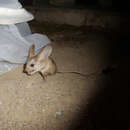en
names in breadcrumbs


Exact forms of communication in long-eared jerboas are not known. However, many species within the family Dipodidae participate in dust bathing. Dust bathing is often a way to use chemical communication. Their keen hearing suggests they may use sounds or vibrations to communicate.
Long-eared jerboas eat flying insects, using sound to locate insects and capture them by performing fast leaps into the air.
Communication Channels: acoustic ; chemical
Other Communication Modes: scent marks
Perception Channels: visual ; tactile ; acoustic ; chemical
The major threat to long-eared jerboas, according to IUCN, is ongoing human disturbance. The IUCN states that the population has undergone an observed or probable reduction of at least eighty percent over the last ten years due to either a decline in area of occupancy, extent of occurrence, and/or quality of their habitat.
US Federal List: no special status
CITES: no special status
State of Michigan List: no special status
IUCN Red List of Threatened Species: least concern
Helicobacter species were found in the feces of long-eared jerboas, suggesting they could carry and transmit this disease.
Negative Impacts: injures humans (carries human disease)
Long-eared jerboas are important members of their native ecosystems.
Long-eared jerboas are insectivorous, impacting insect populations within their range.
Commensal/Parasitic Species:
Long-eared jerboas are insectivorous. They often eat flying insects by using sound to locate them and then capturing them by performing fast leaps into the air.
Animal Foods: insects
Primary Diet: carnivore (Insectivore )
Long-eared jerboas are found in the Palearctic region. They occur from southernmost Mongolia into the Takla-Makan Desert, Mengxin, Aerijin Mountain, and Qing-Zang Plateau regions of north western China.
Biogeographic Regions: palearctic (Native )
Specimens of long-eared jerboas have been collected in sandy valleys that are covered with low growing bushes. Their range includes the Mengxin and Aerjin Mountain regions, which are arid and classified as desert or semi desert. Their range also extends into the Qing-Zang Plateau region, a cold, high elevation desert area. Plant diversity is low in these areas, Haloxylon ammodendron is a low-growing shrub that has been documented at some capture sites.
Habitat Regions: temperate ; terrestrial
Terrestrial Biomes: desert or dune
The longevity of long-eared jerboas is not known. However, average longevity of jerboas is 2 to 3 years.
Long-eared jerboa tail length is 150 to 162 mm, body length is from 70 to 90 mm. The tail is covered with short hairs that are similar in color to the rest of the body except for the terminal tuft, which is white and black. Upper parts are reddish yellow to a light russet color. The belly is white. The hind foot is 40 to 46 mm in length, with five digits. The two lateral digits are shorter than the three central ones. The central metatarsals are fused for a small distance. The feet are covered with tufts of bristly hairs. Long-eared jerboas have ears that are 1/3 longer than their heads. The incisors are thin and white. A small premolar can be found on each side of the upper jaw. Females have eight mammae.
Range length: 70 to 90 mm.
Other Physical Features: endothermic ; heterothermic ; bilateral symmetry
Sexual Dimorphism: sexes alike
Little owls (Athene noctua) are predators of some species in the family Dipodidae in central Asia. Most species in this family take advantage of their excellent hearing to avoid predation by nocturnal predators. Jerboas are also cryptically colored.
Known Predators:
Anti-predator Adaptations: cryptic
Mating systems for long-eared jerboas are not known. However, mating systems of closely related species in the family Dipodidae suggest that they may be polygynous.
For some closely related jerboa species mating usually happens a short time after awaking from winter hibernation. A female will breed twice during the summer season and raise between 2 to 6 young. Gestation time is between 25 and 35 days.
Breeding interval: Breeding can occur twice each season.
Breeding season: Breeding begins shortly after awaking from hibernation.
Range number of offspring: 2 to 6.
Range gestation period: 25 to 35 days.
Key Reproductive Features: iteroparous ; seasonal breeding ; gonochoric/gonochoristic/dioecious (sexes separate); sexual ; viviparous
Little is known about parental investment in long-eared jerboas. Like most mammals, females nurse and care for their young at least until they are weaned.
Parental Investment: pre-fertilization (Provisioning, Protecting: Female); pre-hatching/birth (Provisioning: Female, Protecting: Female); pre-weaning/fledging (Provisioning: Female, Protecting: Female)